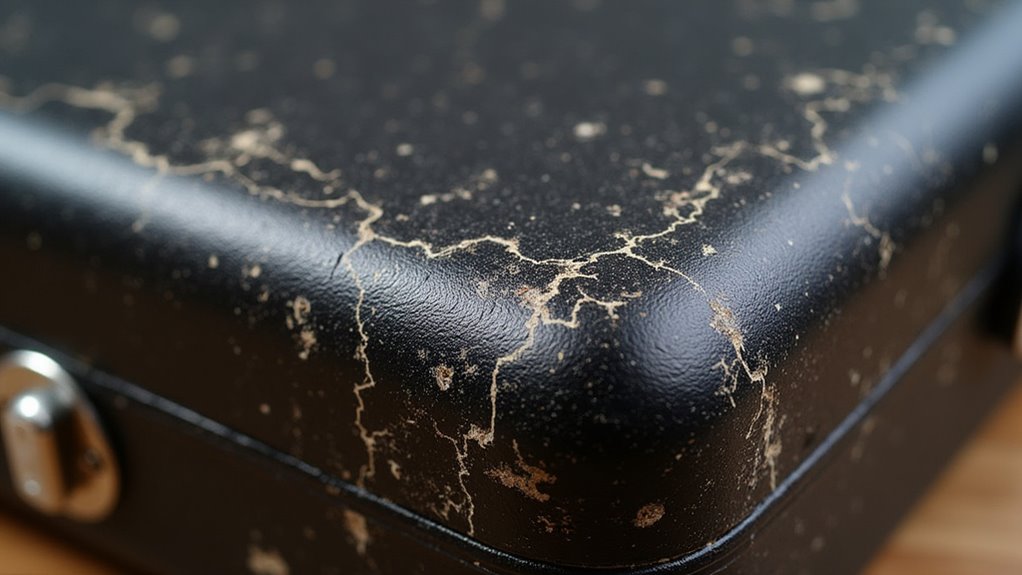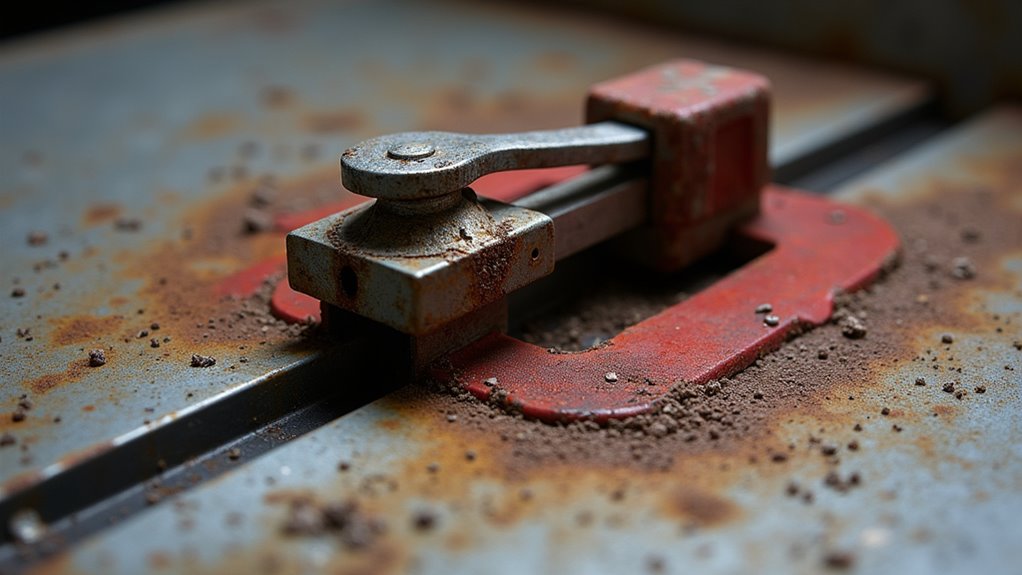The Gator HR1 retractable tonneau cover represents a significant investment for truck owners seeking cargo protection and security.
While this premium cover offers advanced features and sleek aesthetics, users frequently encounter specific operational challenges and durability concerns.
From weather seal integrity to mechanical performance issues, these problems can impact the cover’s functionality and longevity.
Understanding these common complications enables owners to implement preventive measures and maintain peak performance throughout the product’s lifecycle.
Weather Seal Deterioration and Leakage Issues

While the Gator HR1 serves as a popular truck bed cover option, its weather seal system exhibits significant vulnerabilities that compromise cargo protection.
The seals experience accelerated deterioration when exposed to UV rays, creating gaps that allow unwanted moisture and debris to infiltrate the truck bed.
This compromised weather resistance becomes particularly evident during severe weather conditions, with users reporting substantial water accumulation in their cargo areas.
To maintain the cover’s protective capabilities, owners must implement regular maintenance protocols, including frequent seal inspections and timely replacements of degraded components.
Some users have successfully enhanced the cover’s performance by applying supplementary weatherproofing products and sealants, though this represents an additional maintenance requirement.
These interventions prove essential for preserving the cover’s intended function and protecting valuable cargo from environmental exposure.
Latch Mechanism Failure and Sticking Problems
Numerous Gator HR1 users encounter persistent issues with the cover’s latch mechanism, which exhibits a tendency to fail or stick during regular operation.
The primary concerns stem from wear and tear affecting the latching components, resulting in compromised security and restricted access to the truck bed.
Users report that the latch mechanism frequently becomes jammed or unresponsive, particularly in situations requiring quick cargo access.
The design’s durability has been questioned, as premature failures occur more frequently compared to competing tonneau covers.
To mitigate these issues, regular maintenance protocols, including thorough cleaning and lubrication of latch components, are essential for peak functionality.
When problems persist despite proper maintenance, owners should contact customer support to explore warranty options or obtain replacement parts for the affected latch mechanism.
Aluminum Slat Damage and Deformation

Beyond latch mechanism concerns, the Gator HR1’s aluminum slat system presents considerable structural vulnerabilities that affect the cover’s long-term durability.
The tonneau cover’s slats are particularly susceptible to damage from extreme weather conditions, with heavy snow and ice accumulation causing notable deformation.
The problem is compounded by inadequate reinforcement against impact forces, leading to dents and structural compromise when exposed to heavy cargo loads or accidental strikes.
The slat locking mechanisms‘ potential failure introduces additional risks, as loose components become more vulnerable to damage during operation.
Users must remain vigilant about maintenance, as corrosion can develop when the cover faces prolonged exposure to harsh elements.
These structural weaknesses considerably impact the cover’s reliability and protective capabilities, potentially requiring costly repairs or replacement over time.
Installation Compatibility Challenges
Despite its no-drill installation design, the Gator HR1 Tonneau Cover presents several notable compatibility challenges that require careful consideration during setup.
Users frequently encounter issues with bed rail access restrictions, potentially limiting the use of additional accessories.
The installation compatibility challenges extend to variations in OEM rail configurations across different truck models, even within the 2019 Chevy GMC 1500 series.
While the Gator HR1 Tonneau utilizes a clamp-based mounting system, proper hardware alignment and adherence to manufacturer specifications remain critical for peak functionality.
Users must verify their specific bed configuration against the product’s fitment guidelines to avoid installation complications.
The varying compatibility with factory-installed bed accessories necessitates thorough research and potentially additional modifications to guarantee proper installation and long-term performance.
Vinyl Cover Material Wear and Tear

The Gator HR1’s marine-grade vinyl cover material exhibits specific vulnerabilities that impact its long-term durability.
Despite its weather-resistant design, prolonged UV exposure causes fading and deterioration, while extreme temperatures and snow loads can lead to brittleness and cracking of the material.
The vinyl cover faces additional stress points during regular operation, particularly at seams and edges where repeated rolling creates friction-based wear.
When the cover lacks proper tension, sagging occurs between the aluminum support slats, accelerating material fatigue.
While proactive maintenance through cleaning and UV protectant application can mitigate some degradation, the inherent wear patterns remain a concern.
Users must carefully monitor these vulnerabilities to maintain the cover’s protective capabilities and prevent premature replacement due to material failure.
Rolling Mechanism Malfunction
While designed for smooth operation, the Gator HR1’s rolling mechanism exhibits several operational vulnerabilities that compromise its functionality.
The system commonly experiences retraction and extension difficulties due to debris accumulation in the tracks, leading to performance issues that restrict easy access to the truck bed.
Users frequently encounter misalignment problems with the rolling mechanism, resulting in uneven movement that can damage the cover material.
The tension control system requires periodic manual adjustments to maintain proper sealing against weather elements.
In extreme conditions, the mechanism is prone to jamming, further hindering its reliability.
To mitigate these issues, regular maintenance and lubrication of moving components are essential.
Without proper upkeep, the rolling mechanism’s performance deteriorates, potentially compromising the cover’s primary function of protecting cargo.
Clamp System and Hardware Issues

Among reported challenges with the Gator HR1, significant concerns arise from its clamp system and associated hardware components.
The clamp system frequently fails to maintain proper cover security, creating gaps that compromise both weather protection and cargo safety.
Installation hardware, including bolts and clamps, exhibits quality deficiencies that affect long-term durability and adjustment capabilities.
The clamp design presents additional complications by interfering with truck bed rail accessibility, limiting owners’ ability to utilize rail-mounted accessories.
Users must perform regular maintenance through clamp re-tightening to counteract loosening caused by vehicle vibrations.
Further compounding these issues, the limited availability of replacement components for the clamp system can result in extended periods of unusability when parts fail or go missing during installation procedures.
Security Lock Performance Problems
Security concerns with the Gator HR1 manifest prominently through its lock system’s performance deficiencies.
Truck owners report significant issues with lock engagement and disengagement mechanisms deteriorating over time, compromising both bed access and theft prevention capabilities.
The security lock performance problems extend beyond basic functionality issues.
Weather exposure, particularly extreme temperatures, accelerates wear on the locking components, reducing their reliability and compromising the system’s integrity.
The inconvenient placement of locks further compounds these challenges, making rapid access to cargo increasingly difficult.
While the Gator HR1’s security features are intended to protect valuable cargo, documented cases of complete lock failure raise serious concerns about the system’s effectiveness.
These deficiencies undermine the product’s core security function, leaving truck owners vulnerable to potential theft and unauthorized access.
Canister Drainage and Water Collection

Drainage deficiencies in the Gator HR1’s canister system present significant challenges for truck owners.
The design’s intended water channeling functionality often falls short of expectations, with users reporting persistent issues of water accumulation and potential bed leakage.
The canister drainage mechanism’s effectiveness is frequently compromised by debris obstruction in the drainage holes, leading to stagnant water collection.
This design limitation creates areas where water tends to pool rather than flow efficiently through the intended channels.
To maintain peak performance, owners must regularly inspect and clear the drainage system, particularly following heavy precipitation.
The necessity for frequent maintenance interventions raises concerns about the system’s inherent design efficiency.
These drainage complications can potentially compromise the cover’s primary function of keeping truck beds dry and protected.
Noise and Vibration During Travel
The Gator HR1’s operational challenges extend beyond water management to encompass considerable acoustic and kinetic concerns during vehicle operation.
Users frequently report elevated noise levels at higher speeds, primarily attributed to wind resistance and the cover’s aerodynamic design characteristics.
The root causes of these disturbances typically stem from improper installation, inadequate component securement, or loosened hardware over time.
When the tonneau cover isn’t correctly fastened, it produces noticeable rattling sounds that can greatly impact driving comfort.
The cover’s material composition and mounting configuration play essential roles in sound transmission, with vibration intensity varying based on installation quality and maintenance status.
To mitigate these issues, owners should guarantee precise installation according to manufacturer specifications, conduct regular hardware inspections, and consider implementing additional sound-dampening measures where necessary.
FAQs
Is Gator a Good Brand of Tonneau Cover?
Gator maintains a solid brand reputation in the tonneau cover market, offering durable aluminum construction and extensive warranties. Their products generally deliver reliable performance, though long-term durability assessments vary among independent users.
How Long Should a Tonneau Cover Last?
While optimists dream of eternal tonneau covers, reality dictates a typical lifespan of 5-10 years. Hard covers generally outlast soft ones, with proper maintenance and environmental conditions playing essential roles in longevity predictions.
What Are the Disadvantages of a Tonneau Cover?
Tonneau cover disadvantages include restricted bed access, potential interference with tie-downs, maintenance requirements, security vulnerabilities on soft covers, and compatibility limitations. Installation complexity and weather-related wear can also impact long-term performance and functionality.
Do Gator Covers Have a Warranty?
Like a shield protecting your investment, Gator tonneau covers include manufacturer warranties spanning 3-5 years, covering material defects and workmanship issues. The Gator Guarantee provides additional protection when proper installation guidelines are followed.
Final Thoughts
Like the mythical Achilles’ heel, the Gator HR1’s vulnerabilities demand strategic intervention.
From weather seal deterioration to canister drainage complications, these technical issues require systematic maintenance protocols and engineering modifications.
The combined effects of mechanical stress, environmental exposure, and operational wear necessitate thorough solutions to enhance performance reliability and structural integrity, ensuring ideal functionality across diverse usage conditions.
